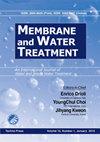通过逐层组装将普鲁士蓝固定在各种过滤材料上以有效吸附铯
IF 1.1
4区 工程技术
Q4 ENGINEERING, CHEMICAL
引用次数: 5
摘要
普鲁士蓝(PB)以其优异的Cs+离子吸附能力而闻名。由于PB在水相中的高分散性,已经引入了将PB嵌入支撑材料中的复合材料作为溶液。然而,在多孔支撑材料内构建PB颗粒仍然是困难的,因为PB颗粒没有完全形成并洗脱到水中。在本研究中,我们建议采用逐层(LBL)组装,以更好地将PB固定在聚乙烯醇海绵(PVA)和纤维素过滤器(CF)的支撑材料上。采用PB浸出试验和Cs+吸附试验对三种不同的PB附着方法,即非原位/原位/LBL组装进行了评价。通过傅里叶变换红外光谱和扫描电子显微镜监测了PB复合材料制备过程中表面功能和形态的变化。结果表明,与其他合成方法(如非原位和原位合成)相比,LBL组装使PB更好地附着在支撑材料上,在水相中洗脱的PB颗粒更少。通过提高吸附剂的稳定性,LBL对PVA-PB的吸附能力提高了9倍,CF-PB的吸附能力增加了20倍以上。因此,结果表明,LBL组装为在多孔支撑材料上生长PB颗粒提供了更好的定向本文章由计算机程序翻译,如有差异,请以英文原文为准。
Prussian blue immobilization on various filter materials through Layer-by-Layer Assembly for effective cesium adsorption
Prussian blue (PB) is well known for its excellent Cs+ ions adsorption capacity. Due to the high dispersibility of PB in aqueous phase, composite materials imbedding PB in supporting materials have been introduced as a solution. However, building PB particles inside porous supporting materials is still difficult, as PB particles are not fully formed and elute out to water. In this study, we suggest layer-by-layer (LBL) assembly to provide better immobilization of PB on supporting materials of poly vinyl alcohol sponge (PVA) and cellulose filter (CF). Three different PB attachment methods, ex-situ/in-situ/LBL assembly, were evaluated using PB leaching test as well as Cs+ adsorption test. Changes of surface functionality and morphology during PB composite preparation protocols were monitored through Fourier transform infrared spectroscopy and scanning electron microscopy. The results indicate that LBL assembly led to better PB attachment on supporting materials, bringing less eluting PB particles in aqueous phase compared to other synthesis methodologies, such as ex-situ and in-situ synthesis. By enhancing the stability of the adsorbent, adsorption capacity of PVA-PB with LBL improved nine times and that of CF-PB improved over 20 times. Therefore, the results suggest that LBL assembly offers a better orientation for growing PB particles on porous supporting materials
求助全文
通过发布文献求助,成功后即可免费获取论文全文。
去求助
来源期刊

Membrane Water Treatment
ENGINEERING, CHEMICAL-WATER RESOURCES
CiteScore
1.90
自引率
30.00%
发文量
0
审稿时长
>12 weeks
期刊介绍:
The Membrane and Water Treatment(MWT), An International Journal, aims at opening an access to the valuable source of technical information and providing an excellent publication channel for the global community of researchers in Membrane and Water Treatment related area. Specific emphasis of the journal may include but not limited to; the engineering and scientific aspects of understanding the basic mechanisms and applying membranes for water and waste water treatment, such as transport phenomena, surface characteristics, fouling, scaling, desalination, membrane bioreactors, water reuse, and system optimization.
 求助内容:
求助内容: 应助结果提醒方式:
应助结果提醒方式:


